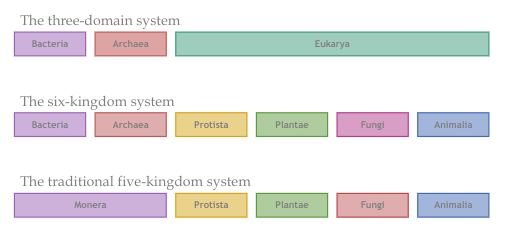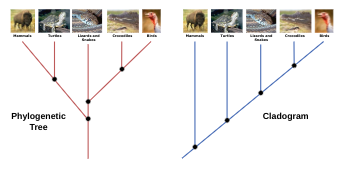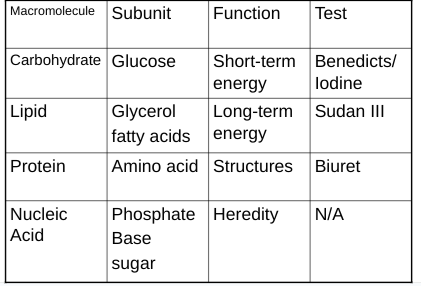Honors Bio Notes
The Scientific Method
Collecting Observations
what is it?
what is happening?
why is that happening?
Forming a Hypothesis
a testable explanation
this is causing the problem
this will cure the disease
a good hypothesis includes: If, then, and because
Making predictions
this medicine will fix the problem
this chemical will make that change
Verifying Predictions
literature review
book research
periodicals
talk to others
Performing Controlled Experiments
Control group
experimental group
independent variable
dependent variable
constant
data gathering
Forming a theory
analyze the data
avg
SD
SEM
report conclusions
Microscopes
Vocab:
Simple Microscope: one lens (magnifying glass)
Magnification: apparent increase in objects size
Resolution: increase in visible detail
Compound Microscope: two lenses
Ocular lens: nearest the eye of viewer
Objective lens: nearest the specimen
Total magnification: ocular magnification X objective magnification (e.g. 10 X 40 = 400)
Parts:
Types of Microscopes:
Simple
one lens
Compound
two lenses
Stereomicroscope
two ocular lenses
Phase Contrast
bends light in a unique way for the study of living cells
Transmission Electron (TEM)
uses a beam of electrons instead of light
can magnify 1,000,000x
samples must be dead
views are flat, one dimensional
Scanning Electron (SEM)
uses a beam of electrons instead of light
can magnify items +/- 100,000x
samples must be dead
views are 3D
History of Microscopes:
First used in mid-1400’s
simple microscope (magnifying glasses)
Compound microscopes came in mid-1500’s
uses 2 lenses together
made by Dutch Father/Son — Hans and Zacharias Janssen
Eyeglass makers
made first compound microscope in 1590
greater magnification, higher distortion
Anton van Leeuwenhoek, 1670’s - 1680’s
Dutch merchant
Made over 400 lenses
magnification of 50-300x
credited with being first to produce drawings of microscoping organisms
Electron microscopes 1935
uses a beam of electrons instead of light
can magnify things many times more than light microscope
Use of Microscopes:
Handle with care
carry with two hands
don’t force
don’t bend cords
cover when possible
turn off when not in use
loosely wrap cords
Use with care
handle slides gently
keep on low power when adding/removing slides
find + focus on low power
increase magnification to next level
refocus
increase magnification to highest level (IF APPROPRIATE)
refocus only with fine focus
return to low power before removing the slide
lower stage to lowest setting
don’t store with slides on stage
Tell The teacher if….
The microscope doesn’t seem to be working properly
if anything breaks
if anything is stuck
Careful in the Classroom
look out for cords
watch where you walk: bookbags
keep a clean/clear work area
Making Lab Drawings
start with a circle: represents field of view
title: centered below circle
total magnification: centered below title
use pencil
start with outline and fill in details
Properties of Life
What characteristics do ALL living things share?
Made of one or more cells
displays organizations
grows and develops
Reproduces
Responds to stimuli
Requires energy
Maintains homeostasis
Adaptations evolve over time
Made of one or more cells:
cells are the smallest thing considered alive
they are the basic units of life
some organisms are 1 cell (unicellular)
humans are made of 9-2 trillion cells (multicellular)
Displays organization:
Levels of organization
Atoms - Molecules - Cells - Tissues - Organs - Organ Systems - Organisms
Grows and develops:
growth = increase in mass or size
develops = different abilities
Reproduces:
produces offspring with similar traits (heredity)
Responds to stimuli:
reacting to internal or external stimuli is called a response
how does your skin respond to sunlight?
how do your eyes respond to darkness?
how does your brain respond to sunlight / darkness?
Requires energy:
some organisms make their own food (autotrophic) (plants)
some organisms eat their food (heterotrophic) (humans)
all the energy and reactions combined are called metabolism
Maintains homeostasis:
trying to keep the internal conditions stable
humans sweat and try to maintain 98.6⁰F or 37⁰C
turtles lay in the sun to try and warm up
Adaptations evolve over time:
adaptations are inherited through reproduction
adaptations changing over time is called evolution
natural selection determines which adaptations help organisms survive
Abiogenesis V. Biogenesis
Aristotle: Abiogenesis (fish)
300 B.C.
Greek
Philosopher
Hypothesis: Fish came from mud
He saw the fish and eggs
Didn’t see adult fish when babies hatched
Jean van Helmont: Abiogenesis (mice)
1600’s
Belgian
Physician
Hypothesis: mice come from dirty shirt and grain in a dark corner
Francesco Redi: Biogenesis (flies)
1668
Italian
Physician
Hypothesis: Flies come from eggs laid by flies
Experiment: various meats in jars
lids on some jars
no lids on others
Results: jars without lids have maggots
Results: Disagreement. People said he denied “active principle” to the jars with lids
Experiment 2: Jars with meats
some jars with screens, some without
Results: jars without screens = maggots, jars with = no maggots
John Needham: Abiogenesis (micro)
Mid 1700’s
English
Scientist
Hypothesis: microscopic living things come from non-living material
Experiment:
boiled meat broth in flasks
examined broth immediately
no organisms
loosely corked flasks
Results: Days later, micro-organisms in flasks
Conclusion: Sterile broth produced living things
Lazzaro Spallanzani: Biogenesis (micro)
late 1700’s
Italian
Priest
Refutes Needhams results based on faulty procedure (corks and flasks weren’t sterile)
Experiment:
boiled seeds for 1 hour
sealed flask by melting neck closed
boiled flasks for hours
Results: days later, broke neck and no living things in broth
Results: people disagreed. He destroyed the “active principle” by overboiling
Experiment 2:
boiled seeds 30 min-2 hrs
Results: found that longer boiling grew more microorganisms
Louis Pasteur: Biogenesis (micro on dust)
1863
French
Chemist
Hired by wine industry to reduce spoilage of grapes
Hypothesis: microorganisms on dust
Experiment 1:
boiled broth and put in different places where dust might be (orchard, woods, field)
Results: all contained microorganisms
Experiment 2:
put broth in flasks
melted flask necks into S-shape
boiled flasks
examined flasks: no organisms, even days later
poured broth into bend of neck
microorganisms grew within a few days
Results: Microorganisms are on dust
Classification
Vocab:
Binomial nomenclature:
2 part name (Genus, species)
8 taxonomic categories
Domain - Species
Systematics:
study of the evolution of biological diversity
Why do we classify organisms?
biologists groups organisms to represent similarities and proposed relationships
classifications systems change with expanding knowledge about new and well-known organisms
Systematics: Evolutionary Classification of Organisms
Systematics is the study of the evolution of biological diversity, and combines data from the following areas:
fossil records
comparative homologies
cladistics
comparative sequencing of DNA/RNA among organisms
Molecular clocks
Kingdoms and Domains:

Kingdom Characteristics
Kingdom Characteristics | ||||||
Domain | Bacteria | Archaea | Eukarya | |||
Kingdom | Bacteria | Archaea | Protista | Fungi | Plantae | Animalia |
Example | Pseudomonas | Methanopyrus | Paramecium | Mushroom | Moss | Earthworm |
Cell Type | Prokaryote | Eukaryote | ||||
Cell Walls | With Peptidoglycan | Without peptidoglycan | Some cellulose | With chitin | With cellulose | No cell walls |
Number Of cells | Unicellular | Uni and multicellular | Most multicellular | Multicellular | ||
Nutrition | Auto or heterotrophic | heterotrophs | Autotrophs | heterotrophs | ||
Hierarchical Classification:
Domain Does
Kingdom King
Phylum Philip
Class Come
Order Over
Family For
Genus Green
Species Soup
Binomial Nomenclature:
2 name system
Genus, species
E.g.:
Homo sapien
Canis domesticus
Felis domesticus
invented by Carolus von Linnaeus
Genus
Noun, capitalized, underlined if handwritten, italicized if typed
species
Descriptive, lower case, underlined if handwritten, italicized if typed
Cladogram
Branching diagram showing proposed classification (phylogeny) or evolutionary history
Groups on a cladogram are called “clades”
a clade is one branch of the cladogram
“Outgroup” = first, most ancestral characters
Characters = traits or characteristics
Ancestral Characters: found in all descendants
Derived Characters: not found in common ancestor
Constructing a Cladogram
Pick Organisms for your cladogram
Pick one ancestral and one derived characteristic to designate the outgroup
Pick derived characteristics for the ingroup 1
Pick derived characteristics for the ingroup 2
Pick derived characteristics for the ingroup 3+
Place and draw the outgroup
Place and draw the ingroup (Pt 1)
Place and draw the ingroup (Pt 2)
Place and draw the ingroup (Pt 3)
Check your cladogram for errors
Taxonomic Diagrams:
 Sometimes, biologists group organisms into categories that represent common ancestries, not just physical similarities. Early naturalists used physical characteristics and later, fossil data, attempting to represent evolutionary relationships among organisms. Today, modern classification systems use fossil data, physical characteristics, and DNA/RNA information to draw increasingly more accurate branching diagrams.
Sometimes, biologists group organisms into categories that represent common ancestries, not just physical similarities. Early naturalists used physical characteristics and later, fossil data, attempting to represent evolutionary relationships among organisms. Today, modern classification systems use fossil data, physical characteristics, and DNA/RNA information to draw increasingly more accurate branching diagrams.
Phylogenetic trees, or phylogenies represent hypothesized evolutionary relationships among organisms and may include extinct as well as modern species.
Cladograms are based only on characteristics observable in existing species. The branching patterns in a cladogram are defined by the presence of unique, evolving innovations (derived characteristics) shared by all members of the group.
Dichotomous Keys Identify Organisms
Dichotomous keys contain pairs of contrasting descriptions
After each description, the key directs the user to another pair of descriptions or identifies the organism
E.g.:
1. a) is the leaf simple? Go to 2
1. b) is the leaf compound? Got to 3
2. a) are the margins of the leaf jagged? Go to 4
2. b) are the margins of the leaf smooth? Go to 5
Evolution
Darwin and the History of Evolution
Competing Ideas About Evolution
Jean-Baptiste LaMarck
French Naturalist, 1744-1829
Theory:
Parents changes passed to offspring
Ex: Giraffes
Won’t work because then tattoos, built up muscle, scars, etc., would transfer to babies
Charles Darwin
English Naturalist, 1809-1882
5 year trip (1831-1836) on HMS Beagle
collecting samples, investigating biology
Theory:
Natural Selection (derived around 1857)
Strongest survive
Wrote book: On the Origin of the Species
Principles of Natural Selection
Variation: Individuals differ
Overproduction: populations produce more offspring than can survive
Heritability: variations are inherited from parents
Reproductive Advantage: some variations are better than others
Evidence of Evolution
Fossils:
Record of species that lived long ago
Derived traits:
Newly evolved
Ex: Feathers
Ancestral traits:
older, more primitive
Ex: Teeth, tails
Comparative Anatomy:
Homologous Structures:
Anatomically similar
Inherited from a common ancestor
ex: vertebrae, forelimbs
Vestigial Structures:
Reduced form of functional structures
ex: snake pelvis, human appendix
Analogous Structures:
Anatomically similar
NOT inherited from a common ancestor
ex: wings of insects & birds
Comparative Embryology:
Early, pre-birth developmental stages
Comparative Biochemistry:
Similar chemicals in organisms
ex: cytochrome C (Needed for respiration)
ex: DNA/RNA
Geographic Distribution:
Where plants and animals are found
closer geographically usually = closer in similarity
Adaptation: Trait shaped by Natural Selection
Fitness:
Measure of relative contribution an individual trait makes to the next generation
Camouflage:
Blend in with the environment
Mimicry:
Resemble another species
ex: monarch (poisonous) & viceroy (harmless) butterflies
Antimicrobial resistance:
Bacteria immune to effects of antibiotics
Shaping Evolutionary Theory:
Mechanisms of Evolution:
Hardy-Weinberg
Hardy-Weinberg Principle
Populations stay the same unless forced to change
Hardy-Weinberg Conditions:
1. Large Population
2. No immigration / Emigration
3. Random mating
4. No mutations
5. No natural selection
Hardy-Weinberg Equation
p2 + 2pq + q2 = 1
Allele + genotype frequencies stay the same unless forced to change
Genetic Drift
Genetic Drift:
change in allele frequency due to chance
Founder effect:
Small, separated populations all have characteristics of “founders”
Bottleneck:
Population declines to small number + rebounds
Gene pool of rebound population is similar to the small population
Ex. Cheetahs in Africa
Gene Flow
Genes coming into or leaving a population
Nonrandom Mating
When mates are chosen
Based on some characteristic
Ex. Galapagos iguana’s: females chose bigger males
Mutation
Change in genetic material
Natural Selection
Selection of individuals that are best adapted for survival
Types of Natural Selection:
Stabilizing: selection against both extremes (pic 2)
Directional: selection against one extreme (pic 1)
Disruptive: selection against the mean (pic 3)
Sexual: when males + females differ greatly in appearance
Reproductive Isolation
Populations that cannot breed and produce fertile offspring
Prezygotic isolation:
Before fertilization begins
Ex. Meadowlark songs, firefly times
Postzygotic isolation:
After fertilization begins
Ex. Lions + tigers
Speciation
Creation of a new species
Allopatric speciation
Physical barrier
Ex. Mountains, rivers
Sympatric speciation
No physical barrier
Ex. Apple maggot flies: depends on fruit eaten
Patterns of Evolution:
Adaptive Radiation/Divergent Evolution
One species gives rise to many others
Ex: Mammals, cichlid fish
Coevolution
Evolution of one species causes evolution of another species because of close relationship
Convergent Evolution
Unrelated species evolve similar traits because of similar ecology / climates in different parts of the world
Ex. Mara and rabbit
Rate of Speciation
Gradualism:
Evolution happens in small, gradual steps
Ex. Stripes of tiger
Punctuated equilibrium:
Abrupt, rapid spurts of change
Ex. snails
Biochemistry
Inorganic: Carbon not present
Water: H2O
Polar
positive / negative charged ends
easily bonds to many things
Solvent
because of polar ends
many things dissolve in it
Heat Capacity
absorbs + holds great amounts of energy before changing phases
Heat of Vaporization: 540 cal/g
Heat of Fusion: 80 cal/g
Acids
H+ ions (Hydronium ions)
pH of 0-7
Bases
OH- ions (Hydroxide ions)
pH of 7-14
pH Scale
0 ----acids----- 7 -----bases-----14
logarithmic scale: each number is 10x greater
ex: 4 is 10x weaker than 3
ex: 5 is 100x weaker than 3
ex: 6 is 1000x weaker than 3
7 is neutral: H+ ions = OH- ions
bases dissolve animal matter
ex: DRANO
Organics: Compounds with Carbon
Reactions:
Condensation
joins molecules together
releases water
ex: making muscles
Hydrolysis
breaks molecules apart
requires water
ex: digestion
Carbohydrates:
Made of C, H, O
Used for short term energy storage
Simple sugars: monosaccharides
ex:
glucose — everything dissolves down to glucose
fructose
galactose
C⁶H¹²O⁶
Benedict’s test:
benedict’s solution (blue)
heat
reacts with glucose
strong positive = orange
weak positive = green
Disaccharides
made from condensation of 2 monosaccharides
maltose
lactose
sucrose
Polysaccharides
long chain sugars
starch
storage in plants
iodine test (brown)
iodine reacts = turns blue/black
Glycogen
storage in animals
Cellulose
structures of plants
Lipids
made of C, H, O
more C&H than O
COmmonly called fats, oils, and waxes
insoluble in water
used for long term energy storage
Used to make cell membranes
Made of glycerol and 3 fatty acids
joined by a condensation reaction
fatty acids contain a carboxyl group
carboxyl group = COOH
Sudan III Test:
attaches to tipids and dyes them pink
Glycerol:
Fatty Acid:
Proteins:
Made of C, H, O, N, and other elements
Used to make structures
blood plasma
enzymes
muscle
wool
fingernails
Made of Amino Acids:
NH² = amino group
COOH = acid (carboxyl group)
Joined together (condensation reaction) to form:
dipeptides = 2 amino acids
polypeptides = 3+ amino acids
there are + / - amino acids
essential amino acids = + / - 10 our bodies can’t make themselves
must be acquired via diet
fibrous proteins
long, stretched out
ex: muscles, spider webs, fingernails
Globular proteins
twisted and folded
ex: hemoglobin
Conformation:
3D shape of a protein
Denature:
break down of 3D shape
due to high temps and sever pH’s
Enzymes:
catalysts: speed up chemical reactions
protein catalysts
coenzymes: help bind to substrate
vitamins: act as coenzymes
inhibitors: slow enzyme activity (poison)
advantages of enzymes:
lower activation energy: reactions happen at normal body temperature
speed up reactions
not used during reactions
Biuret test:
used to detect proteins
NaOH (sodium hydroxide) (clear color)
CuSO⁴ (copper sulfate)(light blue)
when mixed with protein = blue/purple color
Nucleic Acids:
DNA: Deoxyribonucleic acid
records instructions for cell activity
passes into the next generation
ex: tastebuds
proteins shaped by DNA—result: different people have different DNA, so they like different foods
RNA: ribonucleic acid
reads DNA
carries out instructions
SUMMARY:


Genetics
DNA
DNA:
The nucleus of your cells contain chromosomes
Chromosomes have genes
Genes determine what you look like
Chromosomes & genes are made of DNA
DNA = deoxyribonucleic acid
Structure of DNA:
Sides
Phosphate group
Sugar (deoxyribose)
Rungs (4 nitrogenous bases)
Adenine
Guanine
Thymine
Cytosine
Nucleotide = nitrogen base + sugar + phosphate group
Double helix
Nucleotides:
Adenine matches with Thymine
Guanine matches with cytosine
Replication: DNA copies itself
Our bodies produce 2 trillion cells per/day; 25 million cells per/sec. Each cell needs a copy of the DNA.
Original strand of DNA unzips – bonds between nitrogen bases break
Proper nucleotides match to each base
Two identical DNA strands result
Transcription: mRNA is copied from DNA
RNA = Ribonucleic Acid
uses sugar, ribose (not deoxyribose)
uracil replaces thymine as nitrogen base
(and matches with adenine)
RNA is single stranded
Types of RNA:
mRNA = messenger RNA
tRNA = transfer RNA
rRNA = ribosomal RNA
Transcription Process:
DNA unzips
mRNA nucleotides match up to DNA nucleotides
Uracil-Adenine
Guanine-Cytosine
Single strand mRNA forms
DNA rezips
Translation: Making Proteins from the mRNA code
Ribosomes attach to mRNA
- sequence read 3 nucleotides at a time (codon = 3 nucleotides)
tRNA brings amino acids to ribosome by using anticodon
(anticodon = complementary 3 nucleotides)
Amino acids are linked in order of codons
Amino acids joined by peptide bonds
Proteins are formed
Change In Structure = Change in Function
Changes in DNA = Changes in proteins
Central Dogma of Biology:
DNA leads to RNA leads to Protein
Natural Consequences of change in Structure/Function
Variety among individuals
Gene types of changes: Meiosis: Crossing over
Chromosomal Types of Changes:
Nondisjunction:
Trisomy 21:
Down syndrome
Occurs in all racial groups with same frequency
Trisomy 23:
XXY - Klinefelter’s Syndrome
XXX - Triple-X syndrome / super female syndrome
No negatives and most female olympians have this
Trisomy 18:
Edwards Syndrome
92% die within first year
10% live to age 10
Trisomy 13:
Patau’s Syndrome
80% die within first year
13% live to age 10
Most trisomies are lethal
Translocation:
Part of the chromosome moves to another location
Deletion:
Part of chromosome is deleted
Cri du chat:
part of chromosome 5 is deleted
Chronic Granulocytic Leukemia:
Part of chromosome 21 is deleted
Ex: go to the store becomes go to the